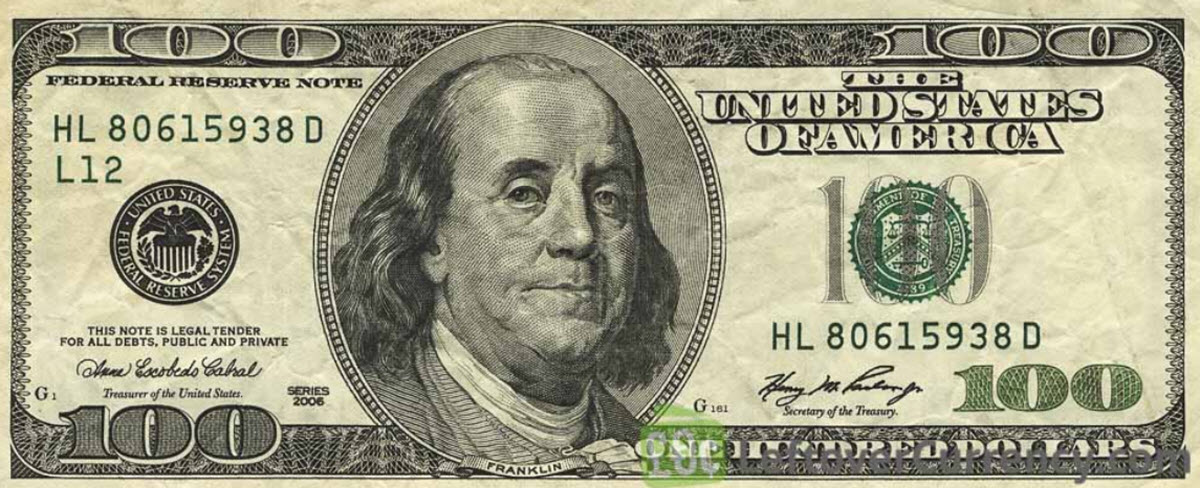The United States dollar is the official currency of the United States of America and its territories. It exist as both metal coins and paper money. The circulating paper money consists of Federal Reserve Notes, also known as United States banknotes, denominated in USD.
Data from June 2018 show that at that point, there were approximately 1.67 trillion USD in circulation, of which $1.62 trillion were Federal Reserve Notes and the remaining billions were coins.
On the global forex market, the USD is the by far most traded currency by value.
Most traded currencies by value (April 2016):
| Rank | Currency | % of daily trades (bought or sold) in April 2016 |
| 1 | United States dollar | 87.6% |
| 2 | Euro | 31.4% |
| 3 | Japanese yen | 21.6% |
| 4 | Pound sterling | 12.8% |
| 5 | Australian dollar | 6.9% |
The basics
Code: USD
Sign: $
Alternative abbreviation: US$
1 USD consists of 100 cents (¢).
Most frequently used banknotes: $1 / $5 / $20 / $50 / $100
Most frequently used coins: 1 cent, 5 cent, 10 cent, 25 cent
Central bank: The Federal Reserve System (also known as the Federal Reserve or simply the Fed) is the central banking system of the United States of America.
Printer: Bureau of Engraving and Printing (BEP)
Minter: United State Mint
Around the world
The United States dollar is the most widely used currency for international transactions and a very important currency in the forex trade. It is te world’s primary reserve currency.
In addition to the countries and territories where the United States dollar is the official currency, there are also many parts of the world where it is the de factor currency or where it is very widely accepted, and in some cases even more desirable, than the official currency.
The United States dollar is the official currency of the following countries:
- United States of America
- East Timor
- El Salvador
- The Federated States of Micronesia
- Marshall Islands
- Palau
- Panama
- Zimbabwe
It is also the official currency of three non-U.S. territories in the Caribbean: The British Virgin Islands, the Caribbean Netherlands, and Turks and Caicos Islands. Both the British Virgin Islands and Turks and Caicos Islands are British Overseas Territories, but use the United States dollar instead of the British Pound. The Caribbean Netherlands are special municipalities of the Netherlands, but use the USD instead of the Euro.

History
The Continental Congress of the United States authorized the issuance of Continental Currency in 1775, but the United States dollar wasn’t defined until the Coinage Act of 1792, by which the United States Congress created the United States dollar as the country’s standard unit of money. The United States Mint was founded in 1792.
Until the Coinage Act of 1857, the Spanish dollar, Mexican peso and United States dollar were all legal tender in the USA.
Etymology
The name dollar ultimately comes from the Joachimstalers, coins minted in the valley Joachimsthal in Bohema in the 1500s. Thal, also spelled Tal, means valley in German. (Today, this valley in Bohemia is a part of the Czech Republic.) The coins where minted here since the valley was a a centre for silver mining.
The Joachimstaler became known in German simply as Thaler or Taler, and this word eventually made its way into many European languages, e.g. daler in Dutch, dalar in Norwegian and tallér in Hungarian. In English, it morphed into dollar, via the Dutch daler. Even today, the English pronounciation of dollar is very similar to the 17th century Dutch pronounciation of daler.
The Leeuwendaler, a Dutch silver coin depicting a lion, became a commonly used coin for merchants in the Dutch East Indies and the Dutch North American New Netherland Colony (in today’s Tri-State area). In the 1600s and early 1700s, the Leeuwendaler circulated throughout the Thirteen British Colonies on the Atlantic coast of North America. In the English-speaking population, it was known as the lion dollar. By analogy, the Spanish peso became known in North America as the Spanish dollar.
When the newly formed United States of America created its own currency in the late 1700s, calling it dollar was a natural choice.
This article was last updated on: March 13, 2019
